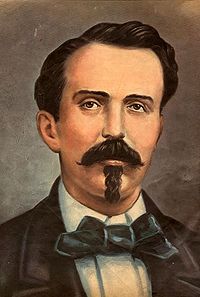The island of Cuba was among the last strongholds for the “peculiar institution” of slavery. While the British, French, Danes, and Dutch abolished slavery by 1863, it remained on Cuba until 1886. The end of slavery came after a hard fought rebellion against the Spanish crown, which began in 1868.
On October 10, 1868, Carlos Manuel de Cespedes began the revolt by issuing his “Grito de Yara.” In this declaration, he announced Cuba independent from the Spanish empire and freed his slaves to fight. In doing so, he solidified himself as a true hero and visionary. Cuban rebels would use guerilla tactics to fight the Spanish and disrupt trade. By the end of the war the rebel forces would control much of the eastern portion of the island. The guerilla tactics of the rebellion continued for years, until the Spanish assured the rebels of their freedom in return for an armistice.
The agreement, which followed was the Pact of Zanjon. This was formalized in February of 1878. The leader of the rebel forces, Antonio Maceo, was unable to accept anything short of Cuban independence and an assurance of the end of slavery. As a result, he fled to New York. The war had failed to overthrow the Spanish rule. However, with the value of sugar decreasing, the need for slaves on Cuba was greatly diminished.
While slaves who had fought in the war were given their freedom, the other enslaved people of the island would remain in their servitude. In 1880, the Spanish declared an end to slavery with and patronato of eight years. This was a time for the slaves to “learn how to be free.” During this time, they were still bound to their masters and did not receive compensation for services rendered. On October 7, 1886, a royal decree finally ended slavery on Cuba. The enslaved people were finally free.
A discussion of influential individuals, which aided in the destruction of slavery on Cuba, must start with Carlos Manuel de Cespedes. For it is his vision for a truly free Cuba and people that began the revolt, which eventually helped end slavery. Another key individual is the valiant leader of the forces: Antonio Maceo. Maceo appears to have led the rebels from 1876 to the end of the war. During this time, he often freed slaves who fought for Cuban independence. Looking for the political realm, it is impossible to ignore Alfonso XIII, King of Spain. It was Alfonso XIII who issued the decree of October 7, 1886, which officially ended slavery on the island of Cuba. Yet, it is the combination of these and countless others, which brought about the end to that wretched institution, which plagued the island.
The existence of a seasoning period exemplified in the patronato, shows the Spanish mindset of the era. In their minds the enslaved people would require time to adjust to the idea of being free. However, the “freedom” of the slaves during this six-year period is contestable as they were bound to their masters without pay. Nevertheless, with the royal decree of 7 October, the slaves became former slaves, closing a horrible, bloody chapter in the history of Cuba.
Sources:
Sierra, J.A. “End of Slavery in Cuba”. Historyofcuba.com. (11/12/11). Retrieved from <http://www.historyofcuba.com/history/race/EndSlave.htm>
Staten, Clifford L. (2003). The History of Cuba. (pp. 31-34). Westport, CT: Greenwood Publishing Group
